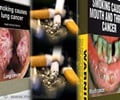Tobacco is the number one cause of preventable deaths across the entire population, especially youth, say health experts.

"Direct smoking causes around five million deaths globally every year with many of these occurring prematurely. An estimated 600,000 are estimated to die every year from effect of second-hand smoke," Baliyan added.
Rajneesh Jain, a cardiologist at the Sir Ganga Ram Hospital, affirmed this and added that if the current trend of tobacco use continues, close to eight million people worldwide will lose their lives annually by 2030.
"Estimates from patients at our oral cancer ward indicate that 80-90 percent of preventable cancers of the neck, head and throat are tobacco-related. More than one million Indians die prematurely from tobacco-related disease each year and the social and economic costs to our community are immense," concurred Pankaj Chaturvedi, cancer specialist at Mumbai's Tata Memorial Hospital. According to Neeraj Gupta, senior consultant, (Pulmonology) at Gurgaon's Paras Hospital, tobacco causes many preventable diseases in various forms including strokes and myocardial infarction, as also lung, mouth and tongue cancer.
"The most common problem caused by smoking is chronic obstructive pulmonary disease (COPD), which is the fifth leading cause of death in the world and is expected to be the third leading cause of death worldwide by 2020," Gupta told IANS.
About 10 percent of COPD patients are young. "With time, it is estimated that by 2020, five out of 10 people shall be affected by COPD due to active or passive smoking," Gupta added.
Advertisement
"Yes," said Jain, adding that the usage of tobacco products by women in the last two decades has seen an increase.
Advertisement
"They need to understand the fact that their body and biological functions are extremely fragile; any type of abnormality can affect them adversely," he said.
Agreed Jain, who said that the risk of developing diseases by smoking are higher in women than men.
"Smoking also has delirious effects on the foetus, and accounts for 30-40 percent of low birth rates. Smoking also increases pre-term deliveries by up to 15 percent," Jain said.
Experts warned that smoking is extremely harmful during pregnancy and advise women to refrain from the habit.
"Smoke has 4,000 chemicals, of which around 69 are carcinogens. Smoking makes it harder to conceive. If both the male and the female smoke, it will result in lower fertility levels. It is proven that smoking reduces the sperm count in males," Kailash Nath Gupta, consultant, Pulmonology and Critical Care, at Gurgaon's Columbia Asia Hospital, told IANS.
"Babies born to mothers who smoke have poor lung functions, and moreover are likely to be smokers in adult life," Gupta added.
Experts agree that kicking the butt may not be easy, but it isn't impossible.
"Will power is important, but only around three percent of smokers are able to do this. Set a quit date, tell friends, family and co-workers that you plan to quit. The other way is nicotine replacement therapy (NRT) such as nicotine patches, nicotine gum and nicotine lozenges," Baliyan explained.
Source-IANS











